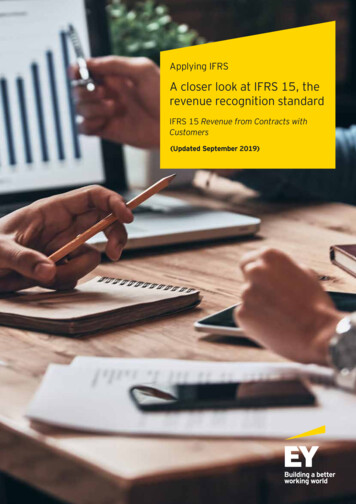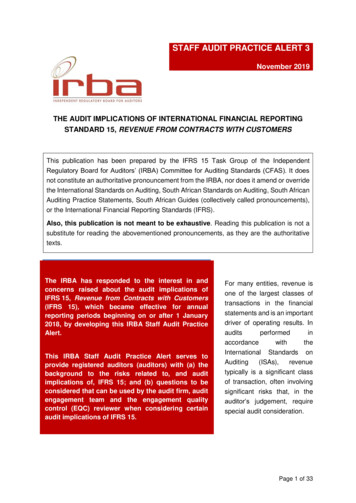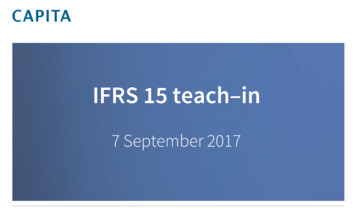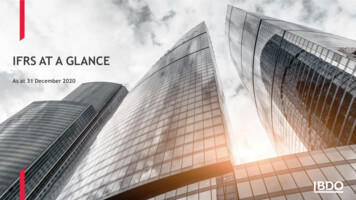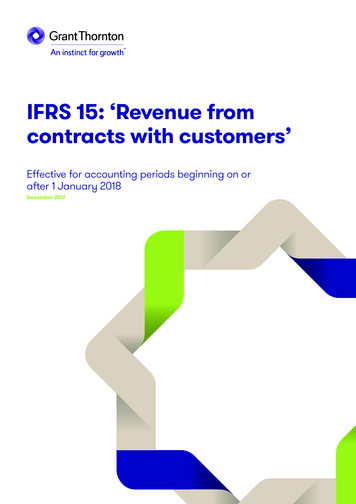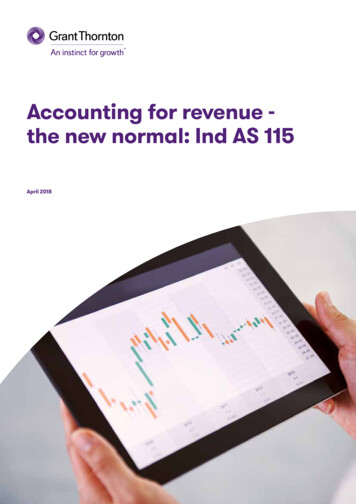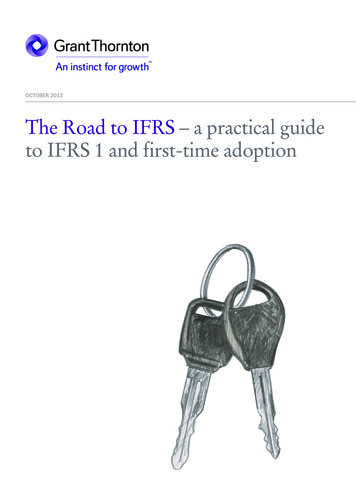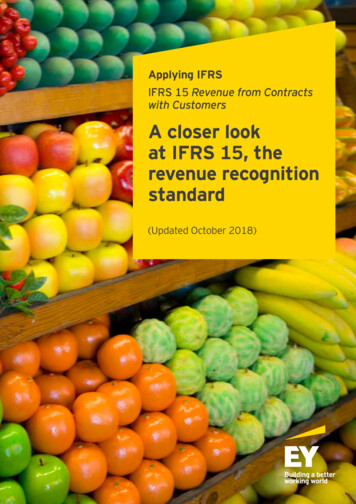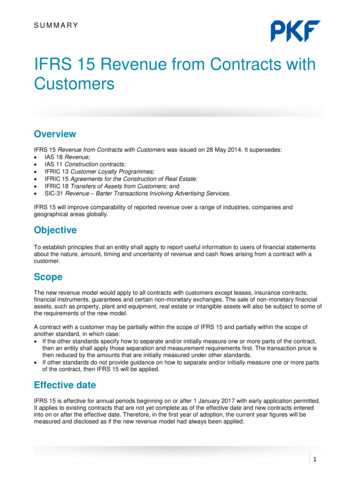
Transcription
SUMMARYIFRS 15 Revenue from Contracts withCustomersOverviewIFRS 15 Revenue from Contracts with Customers was issued on 28 May 2014. It supersedes: IAS 18 Revenue; IAS 11 Construction contracts; IFRIC 13 Customer Loyalty Programmes; IFRIC 15 Agreements for the Construction of Real Estate; IFRIC 18 Transfers of Assets from Customers; and SIC-31 Revenue – Barter Transactions Involving Advertising Services.IFRS 15 will improve comparability of reported revenue over a range of industries, companies andgeographical areas globally.ObjectiveTo establish principles that an entity shall apply to report useful information to users of financial statementsabout the nature, amount, timing and uncertainty of revenue and cash flows arising from a contract with acustomer.ScopeThe new revenue model would apply to all contracts with customers except leases, insurance contracts,financial instruments, guarantees and certain non-monetary exchanges. The sale of non-monetary financialassets, such as property, plant and equipment, real estate or intangible assets will also be subject to some ofthe requirements of the new model.A contract with a customer may be partially within the scope of IFRS 15 and partially within the scope ofanother standard, in which case: If the other standards specify how to separate and/or initially measure one or more parts of the contract,then an entity shall apply those separation and measurement requirements first. The transaction price isthen reduced by the amounts that are initially measured under other standards. If other standards do not provide guidance on how to separate and/or initially measure one or more partsof the contract, then IFRS 15 will be applied.Effective dateIFRS 15 is effective for annual periods beginning on or after 1 January 2017 with early application permitted.It applies to existing contracts that are not yet complete as of the effective date and new contracts enteredinto on or after the effective date. Therefore, in the first year of adoption, the current year figures will bemeasured and disclosed as if the new revenue model had always been applied.1
Defined termsIFRS 15 defines the following terms that form an integral part of this IFRS.Contract – An agreement between two or more parties that creates enforceable rights and obligations.Customer – A party that has contracted with an entity to obtain goods or services that are an output of theentity’s ordinary activities in exchange for consideration.Income – Increases in economic benefits during the accounting period in the form of inflows orenhancements of assets or decreases of liabilities that result in an increase in equity, other than thoserelating to contributions from equity participants.Performance obligation – A promise in a contract with a customer to transfer to the customer either:a) A good or service (or a bundle of goods or services) that is distinct; orb) A series of distinct goods or services that are substantially the same and that have the same pattern oftransfer to the customer.Revenue – Income arising in the course of an entity’s ordinary activities.Transaction price (for a contract with a customer) – The amount of consideration to which an entity expectsto be entitled in exchange for transferring promised goods or services to a customer, excluding amountscollected on behalf of third parties.The revenue modelThe standard introduces a revenue model in which the core principle is that an entity should recogniserevenue to depict the transfer of promised goods or services to the customer in an amount that reflects theconsideration to which the entity expects to be entitled in exchange for those goods or services.Allocate thetransactionpriceSTEP 5Determine thetransactionpriceSTEP 4Identify theperformanceobligations inthe contractSTEP 3Identify thecontract(s)with thecustomerSTEP 2STEP 1To recognise revenue the following five steps should be applied:Recogniserevenue whena performanceobligation issatisfiedStep 1: Identify the contract(s) with the customerA contract can be oral, written or implied by an entity’s business practice. A contract with a customer will fallwithin the scope of IFRS 15 when all the following criteria are met: The parties to the contract have approved the contract; Each party’s rights in relation to the goods or services to be transferred can be identified; The payment terms and conditions for the goods or services to be transferred can be identified; The contract has commercial substance; and The collection of an amount of consideration to which the entity is entitled to in exchange for the goods orservices is probable.If the above criteria are met, a contract shall not be re-assessed unless there is an indication of a significantchange in facts or circumstances, however if the contract does not meet the above criteria the entity willcontinue to re-assess the contract going forward to determine whether the criteria are subsequently met.IFRS 15 Revenue from Contracts with Customers2
The model is to be applied on an individual contract basis. However, as a practical expedient, a portfolioapproach is permitted for contracts with similar characteristics provided it is reasonably expected that theimpact on the financial statements will not be materially different from applying this model to the individualcontracts.A contract modification shall be accounted for as a separate contract if the following conditions are met: There is an addition of promised goods or services that are distinct and which increases the scope of thecontract; and The price of the goods of the contract increases by an amount of consideration that reflects the entity’sstand-alone selling prices of the additional goods or services and any appropriate adjustments to thatprice to reflect the circumstances of the particular contract.If the above conditions are not met, a contract modification will be accounted for prospectively orretrospectively (depending on whether the remaining goods or services to be delivered after the modificationare distinct from those delivered prior to the modification) by modifying the accounting for the currentcontract with the customer.Step 2: Identify the performance obligations in the contractAt contract inception, an entity shall assess the goods or services that have been promised to the customer,and shall identify as a performance obligation: A good or a service (or a bundle of goods or services) that is distinct; or A series of distinct goods or services that are substantially the same and that have the same pattern oftransfer to the customer.A good or service is distinct if the following criteria aremet: The customer can benefit from the good or service on itsown or together with other readily available resources;and The entity’s promise to transfer the good or service to thecustomer is separately identifiable from other promises inthe contract.A series of distinct goods or services has the samepattern of transfer to the customer if the following criteriaare met: Each distinct good or service that the entity promises totransfer consecutively to the customer would be aperformance obligation that is satisfied over time; and The same method of measuring progress would be usedto measure the entity’s progress towards the completesatisfaction of the performance obligation to transfer eachdistinct good or service in the series to the customer.Factors for consideration as to whether an entity’s promise to transfer the good or service to the customer isseparately identifiable include, but are not limited to: The entity does not provide a significant service of integrating the good or service with other goods orservices promised in the contract. The good or service does not significantly modify or customize another good or service promised in thecontract. The good or service is not highly dependent on or highly interrelated with other goods or servicespromised in the contract.IFRS 15 Revenue from Contracts with Customers3
Example – Determining whether goods or services are distinctThis is an adaptation from IFRS 15, Illustrative examples, Example 11.An entity, a software developer, enters into a contract with a customer to transfer the following: Software licence; Installation service (includes changing the web screen for each user); Software updates; and Technical support for 2 years.The entity sells the above separately. The installation service is routinely performed by other entities and does notsignificantly modify the software. The software remains functional without the updates and the technical support.Are the goods or services promised to the customer distinct in terms of IFRS 15?The software is delivered before the other goods or services and remains functional without the updates and the technicalsupport, therefore the entity concludes that the customer can benefit from each of the goods and services either on theirown or together with the other goods and services that are readily available.The promise to transfer each good and service to the customer is separately identifiable from each other. In particular, theinstallation service does not significantly modify or customize the software itself and, as such, the software and theinstallation service are separate outputs promised by the entity instead of inputs used to produce a combined output.Based on the assessment, four performance obligations in the contract have been identified for all four of the above goodsor services.Step 3: Determine the transaction priceThe transaction price would be the amount of consideration that an entity expects to be entitled to inexchange for transferring promised goods or services to a customer. An entity will consider the terms of thecontract and past customary business practices when making this determination.If a contract contains a variable amount, the entity willestimate the amount to which it will be entitled under thecontract. The consideration can also vary if an entity’sright to consideration is contingent on the occurrence ofa future event. The variable consideration is onlyincluded in the transaction price to the extent that it ishighly probable that a significant reversal in the amountof cumulative revenue recognised will not occur whenthe uncertainty associated with the variableconsideration is subsequently resolved.Examples of where a variable considerationcan arise DiscountsRefundsPrice concessionsPerformancebonuses RebatesCreditsIncentivesPenaltiesAn adjustment for the time value of money is made to a transaction price for the effects of financing, ifpresent and significant to the contract, for example, where a consideration is paid in advance or in arrears. Apractical expedient is available where the interval between the transfer of promised goods or services andthe payment by the customer is expected to be less than 12 months.IFRS 15 Revenue from Contracts with Customers4
Example – Volume discount incentiveThis is an adaptation from IFRS 15, Illustrative examples, Example 24.Big Bed enters in a contract with a customer to sell beds for 400 per bed on 1 January 2017. If the customer purchasesmore than 1000 beds in a calendar year, the contract states that the price per unit is retrospectively reduced to 380 perunit. As a result of this the consideration in the contract is variable.As at 31 March 2017, Big Bed sells 80 beds to the customer, therefore Big Bed estimates that the customer’s purchase willnot exceed the 1000 bed threshold required for the volume discount in the calendar year.When considering the requirements of IFRS 15 (in particular paragraphs 56 – 58) and the significant experience Big Bedhas with this product and the entity’s purchasing pattern, it was concluded that it is highly probable that a significant reversalin the cumulative amount of revenue recognised ( 400 per bed) will not occur when the uncertainty is resolved (i.e. when thetotal amount of purchases is known). Consequently, the entity recognises revenue of 32,000 (80 beds x 400) for the firstquarter ended 31 March 2017.At the beginning of June 2017, the customer acquires another company and at the end of the second quarter, 30 June 2017,Big Bed sells an additional 500 beds to the customer. In light of the new fact, Big Bed estimates that the customer’spurchases will exceed the 1000 bed threshold for the calendar year and therefore it would have to retrospectively reduce theprice per unit.Big Bed therefore recognizes revenue of 188,400 for the quarter ended 30 June 2017. The amount is calculated from 190,000 (500 beds x 380) less the change in transaction price of 1,600 (80 beds x 20 price reduction) for the reductionof the beds sold in the first quarter.Step 4: Allocate the transaction priceAn entity shall allocate the transaction price to each performance obligation in an amount that depicts theamount of consideration to which the entity expects to be entitled in exchange for transferring the promisedgoods or services to the customer.Where a contract has many performance obligations, an entity shall allocate the transaction price to theperformance obligations in the contract by reference to their relative stand-alone selling prices. If a standalone selling price is not directly observable, an entity will need to estimate it. IFRS 15 suggests variousmethods that may be used, including: Adjusted market assessment approach; Expected cost plus a margin approach; or Residual approach (only permissible in limited circumstances).Sometimes the transaction price may include a discount. Any overall discount is allocated between theperformance obligations on a relative stand-alone selling price basis. In some circumstances it may beappropriate to allocate the discount to some but not all of the performance obligations.IFRS 15 Revenue from Contracts with Customers5
Example – Allocating a discount to one or more performance obligationsThis is an adaptation from IFRS 15, Illustrative examples, Example 34.A fashion outlet named Fashionable regularly sells scarves, shoes and handbags individually, thereby establishing standalone selling prices as illustrated below.In addition, Fashionable regularly sells shoes and handbags together for 60.ScarfShoesHandbag 40 55 45Fashionable enters into a contract with a customer to sell all threeproducts in exchange for 100. Fashionable will satisfy the performanceobligations for each of the products at different points in time.The contract includes a discount of 40 on the overall transaction. Thisdiscount will be allocated proportionately to all three obligations whenallocating the transaction price using the relative stand-alone selling pricemethod. However, because Fashionable regularly sells shoes and handbags together for 60 and Scarves for 40, it hasevidence that the entire discount should be allocated to the promises to transfer shoes and handbags in accordance withparagraph 82 of IFRS 15.Total 140If Fashionable transfers control of the shoes and handbags at the same point in time, then Fashionable could as a practicalmatter account for the transfer of those products as a single performance obligation. That is, the entity could allocate 60 ofthe transaction price to the single obligation and recognise revenue of 60 when shoes and handbags are simultaneouslytransferred to the customer.If the contract requires Fashionable to transfer the control of the shoes and handbags at different points in time, then theamount of 60 is individually allocated to the products based on their stand-alone selling price as follows:ShoesHandbagTotal 33 ( 55 100 [total stand-alone selling price] x 60) 27 ( 45 100 [total stand-alone selling price] x 60) 60Step 5: Recognise revenue when a performance obligation is satisfiedAn entity shall recognise revenue when (or as) it satisfies a performance obligation by transferring apromised good or service to a customer, which is when control is passed, either over time or at a point intime.Control of an asset means having the ability to direct the use of, and obtain substantially all of the remainingbenefits from, the asset.An entity recognises revenue over time if one of the following criteria are met: The customer simultaneously receives and consumes the benefit provided by the entity as the entityperforms; The entity’s performance creates or enhances an asset that the customer controls as the asset is createdor enhanced; or The entity’s performance does not create an asset with an alternative use to the entity and the entity hasan enforceable right to payment for the performance completed to date.For a performance obligation satisfied over time, an entity would select an appropriate measure of progressto determine how much revenue should be recognised as the performance obligation is satisfied.Factors which may indicate that control is passed at a point in time include, but are not limited to: The entity has a present right to payment for the asset; The customer has legal title to the asset; The entity has transferred physical possession of the asset; The customer has significant risks and rewards related to the ownership of the asset; and The customer has accepted the asset.IFRS 15 Revenue from Contracts with Customers6
Contract costIncremental costs of obtaining a contractIf the entity expects to recover incremental costs of obtaining a contract with a customer, the entity shallrecognise those costs as an asset. The incremental costs are those costs that an entity incurs to obtain acontract that it would not have incurred if the contract had not been successfully obtained, for example, asales commission. A practical expedient however exists, allowing the incremental costs of obtaining acontract to be expensed if the amortisation period would be one year or less.Example – Incremental costs of obtaining a contractThis is an adaptation from IFRS 15, Illustrative examples, Example 36.A consulting services entity, wins a competition bid to provide consulting services to a new customer. The following costswere incurred by the entity to obtain the contract: External legal fees for due diligence15,000Travel costs to deliver the proposal25,000Commissions paid to sales employees 10,000Total costs incurred50,000In accordance with IFRS 15 (paragraph 91), the entity recognises an asset for the 10,000 (commission) incremental costsof obtaining the contract because the entity expects to recover those costs through future fees for consulting services. Theentity also pays discretionary annual bonuses to sales employees based on annual sales targets, overall profitability andindividual performance. Taking into account IFRS 15 (paragraph 91), the entity does not recognise an asset for the bonusespaid because they are not incremental to obtaining a contract. The bonus amounts are discretionary and are based on otherfactors, including the overall profitability of the entity and the individuals’ performance therefore they are not directlyattributable to identifiable contracts.The legal fees and travel costs would have been incurred whether the bid was won or not, therefore those costs arerecognised as expenses when incurred (IFRS 15, paragraph 93), unless they are within the scope of another Standard, inwhich case the relevant provisions of that standard apply.Costs to fulfil a contractCosts incurred to fulfil a contract with a customer are recognised as an asset only if all the following criteriaare met: The costs relate directly to a contract or to anExamples of the type of costs that may beanticipated contract that the entity can specificallyincurred to fulfil a contractidentify; Direct labour The costs generate or enhance resources of the Direct materialsentity that will be used in satisfying performance Allocation of overheads that relate directly toobligations in the future; andthe contract The costs are expected to be recovered. Cost that are explicitly chargeable to theAn asset recognised with regard to the above cost shallbe amortised on a systematic basis that is consistentwith the pattern of transfer of the goods or services towhich the asset relates. customer under the contractOther costs that are incurred only because anentity entered into the contractPresentationAn entity shall present the performance of a contract in the statement of financial position as a contract assetor contract liability, depending on the relationship between the entity’s performance and the customer’spayment. Any unconditional rights to consideration shall be presented separately as a receivable.IFRS 15 Revenue from Contracts with Customers7
Where a customer has paid an amount of consideration prior to the entity transferring the related good orservice to the customer, a contract liability will be presented in the statement of financial position.Where the customer has not yet paid the related consideration for the transfer of a good or service, acontract asset (right to consideration is conditional on something other than the passage of time) orreceivable (right to consideration is unconditional except for the passage of time) is presented in thestatement of financial position. Contract assets and receivables together with any impairment shall beaccounted for in accordance with IFRS 9 Financial Instruments. The difference between the initialrecognition of a receivable and the amount of revenue should be presented as an expense.DisclosureSufficient information to enable users of financial statements to understand the nature, amount, timing anduncertainty of revenue and cash flows arising from contract with customers shall be disclosed. To achievethis, an entity shall disclose the qualitative and quantitative information about all of the following:Revenue recognised from contracts with customers, including The disaggregation of revenue into appropriate categoriesFor contract balances- The opening and closing balances of receivables, contract assets and contract liabilities- Revenue recognised in the reporting period that was included in the contract liabilities opening balance- Revenue recognised in the reporting period from performance obligations satisfied in previous periodsFor performance obligations, a description of- When the company typically satisfies its performance obligations- The significant payment terms- The nature of the goods or services that the entity has promised to transfer- Obligations for returns, refunds and other similar obligations- Types of warranties and related obligationsThe amount of the transaction price that is allocated to the remaining performance obligations in a contractThe significant judgements, and changes in judgements, made in applying this standard to those contracts, inparticular The timing of satisfaction of performance obligationsThe transaction price and the amounts allocated to performance obligationsAny assets recognised from the costs to obtain or fulfil a contract with a customer, including A description of the judgements made in determining the amount of the costs and the amortisation method used for eachreporting periodThe closing balances of the assetsThe amount of amortisation and any impairment losses recognised in the reporting periodTransitionEntities are allowed to choose whether to apply IFRS 15 retrospectively to each prior period presented (withoptional practical expedients) or retrospectively according to an alternative transition method. Under thealternative transition method, restatement of comparative years is not required but the cumulative effect ofinitially applying IFRS 15 should be recognised as an adjustment to the opening retained earnings on theeffective date (in the year of initial application). Additional disclosures are then required to illustrate theeffects of applying the standard.IFRS 15 Revenue from Contracts with Customers8
IFRS 15 Revenue from Contracts with Customers 2 Defined terms IFRS 15 defines the following terms that form an integral part of this IFRS. Contract - An agreement between two or more parties that creates enforceable rights and obligations. Customer - A party that has contracted with an entity to obtain goods or services that are an output of the .
